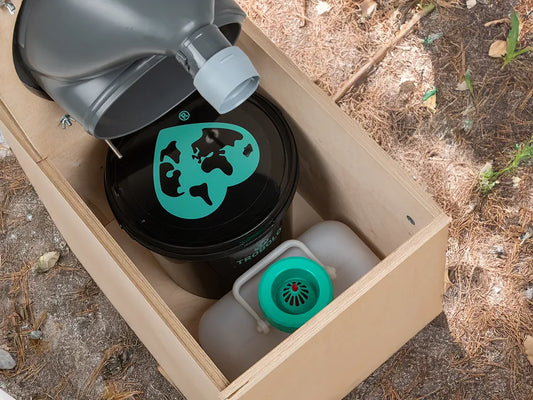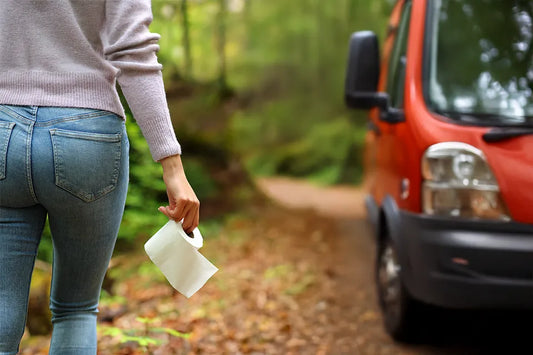Step-by-step guide to emptying a composting toilet
To understand how to empty composting toilets, let's quickly review how they work. A composting toilet with urine diverters can be used just like regular toilets but automatically separates liquid and solid waste into two containers.
This makes emptying your composting toilet very easy. Just open it from above and remove the container you wish to empty. Whether you opt to remove both containers simultaneously or individually is entirely up to you.
And no worries, the process is absolutely clean and hygienic. The containers stay spotless, so you won't get dirty when handling them. You can confidently remove them from the toilet without the need for gloves.

Plus, the solids container has an inlay that prevents any direct contact with waste. All solid waste goes straight into the inlay, facilitating effortless disposal while maintaining cleanliness. To cater for all needs, we offer inlays made from recycled plastic and inlays made from compostable cornstarch, which are ideal if you wish to compost your toilet waste.
Both the liquids and solids containers can be securely closed, ensuring hassle-free transportation to the desired disposal site. You can even transport the containers in your car without any concerns about spillage.

As for disposal, you have several options.
Solid waste can be disposed of with your household waste, much like used diapers. Alternatively, you can compost the solid waste, provided you use a compostable inlay and have a suitable composter at hand. For composting toilet waste a closed composter is recommended in order to prevent the developtment of black water due to penetrating rainwater.
For the liquid waste, you also have two options. The collected liquid waste can be poured into a regular toilet when it’s time to empty the liquid container. Alternatively, you can dilute the liquid waste with water and use it as natural fertilizer for ornamental plants.
How often should you empty your composting toilet?
The frequency at which you'll need to empty your liquids and solids containers varies based on several factors, including container size, ambient temperature, frequency of use, and whether you've opted for our unique TROBOLO SafeShell System®.
As a general guideline, we recommend emptying the solids container no later than every 10 days and the liquids container no later than every 4 days. However, during warmer weather, it's advisable to empty them more frequently.
If you use our TROBOLO SafeShell System®, you can empty the liquids container independently of any specific time frame.
Cleaning your composting toilet
Luckily, cleaning your composting toilet is easy. Is it as easy as cleaning a conventional toilet? Well, it is actually even easier.
Thanks to the urine diverter, solid waste never touches any surfaces, It lands directly in the inlay of the solids container, eliminating any concerns about stains on the urine diverter or any other part of the toilet. Additionally, since everyone is required to sit down, there's no worry about urine on the toilet seat.
To maintain cleanliness, simply use a damp cloth to wipe down the surfaces form time to time. Occasionally, you may want to rinse the containers with water, which is absolutely sufficient to keeping them clean. It's important to avoid harsh chemical cleaning agents, as they can damage the material. Instead, opt for a natural cleaning solution by diluting citric acid powder with water. With these simple steps, your composting toilet will stay fresh and hygienic with minimal effort.
Our products










